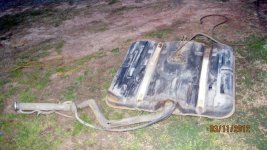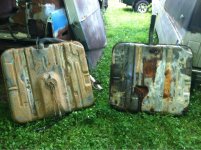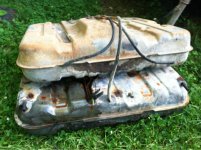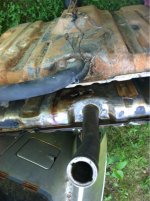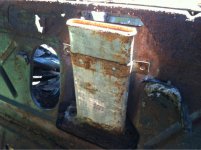Are these cc special tanks? Also are they builder specific?
You are using an out of date browser. It may not display this or other websites correctly.
You should upgrade or use an alternative browser.
You should upgrade or use an alternative browser.
1971-1976 gas tanks
- Thread starter Chris Elzie
- Start date
Keith Snyder
PCS Member
Like Cadillac passenger cars, the Cadillac commercial chassis all used the same tank - there were no special tanks for different coachbuilders. Having said that, the filler necks could and have been at times repositioned from what the Cadillac passenger car's standard position was. Some makers had the filler beside the rear loading door, some on the rear fender. That was the coachbuilders perogative and dictated by the tank and the coachbuilders engineers. Tanks themselves in the commercial chassis, all the same for any specific year with some being used for several consecutive years unchanged.
so far from what I can tell the 71 to 76 years used the standard tank and cut the filler neck off. the curved rubber hose was used on them to fill the tank with the stub of the original neck. the 59 to 70 used the standard tank out of the 58 Caddy. they used the sending unit out of the same tank. now that being said I don't have a tank out of a 71 to 76 to compare with the standard tank so look it over well as for vent tube placement and were the draw and return lines go.
Speaking from experience. Those tanks are different but you can use a regular Cadillac tank like the other guys stated. To answer your question, they were a part that was supplied with the C.C. chassis. Not builder specific. One of the first repairs I did to my 76 M+M was replace the tank. The shape of the tank and sending unit are identical. Has the correct ohms. You can just cut off the neck on the regular tank but you won't have a vent. First thing you'll see is that the tube is split in two by a sheet of metal. The C.C. tank has a vent fitting. If you don't have this, it will take forever to fill your tank. It's like tipping a bottle upside down, the air inside the tank needs to leave as it's being filled. I added a piece of plumbing to mine so you can connect a hose. This needs to be soldered. The metal that tanks are made out of will crack is you try and weld it. A buddy of mine that used to work at a radiator shop told me this. I'd fill the tank with water when you choose to do this. IT IS VERY DANGEROUS! It was one of the scariest things I've ever done. You could see fumes igniting even with water in the tank. Water helps even when you're cutting the neck off too to prevent metal shavings from entering the tank. Of course, you're gonna want to let this dry out before you put any gasoline in it. Gasoline antifreeze would be a good idea to put in there on the first fill if you put water in the tank. It'll displace the water.
one could have soldered or welded the vent to a tab of metal drilled a hole in the tank and screwed to the top with a gasket same as the sending unit. I'm guessing that the vent is internal one coming out the fill hole or the shorter flat neck would vent it's self. but I remember your trouble with it. glad to here you got it fixed
Gas tank
Thank you, for posting the picture Ed. The gas tank actually belongs to a non member on the east coast. I am giving the owner some help selling off his 1973 Cadillac Superior in parts in exchange for some discounted parts for myself. I have a list of parts pulled and ready for sale if anyone is interested you can PM me. I wanted to submit the picture primarily to assist in the discussion. Hope that this photo is of some benefit to the topic.
Thank you, for posting the picture Ed. The gas tank actually belongs to a non member on the east coast. I am giving the owner some help selling off his 1973 Cadillac Superior in parts in exchange for some discounted parts for myself. I have a list of parts pulled and ready for sale if anyone is interested you can PM me. I wanted to submit the picture primarily to assist in the discussion. Hope that this photo is of some benefit to the topic.
Does anyone know where to get a replacement gas tank filler hose? If so please advise. Our filler door is on the rear of the car left of the loading door. I searched the forums and this was the closest thread I found dealing with this topic. Is there a part number? Who was the manufacturer of the original? Thank you.
If you are referring to the hose that connects the filler neck to the tank, that part is available at most auto parts stores. If you need the steel filler tank neck, then you are left with finding a used one from a similar car.
Nicholas Yassan
PCS Life Member
Paul, it is the rubber connecting hose that we need. Is this a stock Cadillac item or is there another description or part number that we should ask for?
Just bring the tube to any NAPA or Carquest auto parts store, and they should have it in stock or if they have to order it, it shouldn't take but a day. They will need the tube to determine the size. It is usually sold in 6" piece.
Jeremy D. Ledford
PCS Volunteer Chapter President
Since we can post photos from an iPhone now here are a few shots that I made comparing a 71-76 Cadillac commercial chassis tank to a 71-76 Cadillac passager car tank. There are a number of differences. The passager car tank has extra lines that were used on a anti-vapor lock system, the sending unit is held in by Phillips screws, the sending unit does not have the hump in the top of the tank like the commercial chassis tank and the filler neck is different. If you were in a pinch you prolly could make a passenger car tank work with some modifications. The passenger car tank pictured was from a 1972 Cadillac DeVille and the commercial tank was from a 1973 M-M. Due to the rusted put nature and condition of the passenger car tank was in it was scrapped after the photos were made.
Attachments
Jeremy D. Ledford
PCS Volunteer Chapter President
It isn't a anti vapor lock system, but a vapor recovery system. The vapor lock problem was solved by installing a return line to the tank from the fuel pump and routing the gas line to carburetor in a way that kept it away from the hot exhaust gasses (i.e. exhaust manifold). It would also help if you identify which is the commercial chassis tank... the one on the right or the one on the left?
thanks
thanks
Jeremy D. Ledford
PCS Volunteer Chapter President
For the "uneducated" the tank on the right is the passenger car tank and the tank to the left is the commercial chassis tank. In the stacked tank photo the bottom tank is the DeVille tank and the top tank is the commercial tank. All lines coming and going on the passenger car tank went through the canister behind the seat.
the biggest thing I see would be the lack of a vent and the CC tank is recessed more at the filler neck. you can add the vent but would have to move the tank forward to cut the neck off and get the hose conected. then just plug off any lines not used. the CC would only have the return, suction and vaper canister if I recall right. pinch off the filler hose and no vent you will never get it full of gas.


